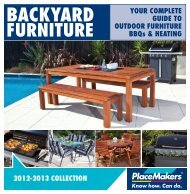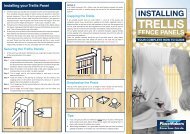Saving energy around your home. - PlaceMakers
Saving energy around your home. - PlaceMakers
Saving energy around your home. - PlaceMakers
- No tags were found...
You also want an ePaper? Increase the reach of your titles
YUMPU automatically turns print PDFs into web optimized ePapers that Google loves.
HOW TO1<strong>Saving</strong> <strong>energy</strong><strong>around</strong> <strong>your</strong> <strong>home</strong>.www.placemakers.co.nz
Checklist of Energy <strong>Saving</strong> ProductsInsulationWindow ShadesCurtains or DrapesAwningsDoorsPlastic Window MaterialSealantsWeatherstripFansAttic VentilatorsThermometersGable VentsFireplaces and AccessoriesWood StovesLight DimmersClock ThermostatsWater-SaversTap RepairsAbout 54% of the <strong>energy</strong> used in <strong>home</strong>s goes intoheating and cooling. This is where the average familycan make the biggest savings on its <strong>energy</strong> costs.Fortunately, many ways to save <strong>energy</strong> can beaccomplished quickly and inexpensively. You don'thave to be a master mechanic or even a skilled doit-<strong>your</strong>selfer.All it takes is a small amount of time,a few tools that you probably already own, andsome products from <strong>your</strong> convenient, helpful<strong>PlaceMakers</strong> branch.Figure 1: Thermostat1
Hot Weather Energy SaversDeflect daytime sun with awnings on windows or drawdrapes and pull shades on sunny windows. Use anextractor ventilating fan instead of air conditioning.They do a remarkably good job in keeping air circulating.A 130m 2 attic should have at least .5m 2 of ventilation.Combine circulating fans with room air-conditionersfor best air distribution throughout the house.Year Round Energy SaversUse fluorescent lights where possible. A 25 wattfluorescent tube will provide light equal to a 100 watt bulb.Replace leaky taps; repair all water-wasting fixtures.A dripping hot water tap makes a hot water heaterkeep working.Close off unused rooms.Kitchen, Laundry and BathroomInsulate the hot water cylinder and piping with insulatingmaterials e.g. Climaflex.Have hot-water-using appliances such as clothes anddishwashers full, but not overloaded; same for clothesdryers (use drying racks or clothes lines if possible butalways outside).Use warm or cold water (rather than hot)whenever possible.Keep the thermostat on <strong>your</strong> hot water cylinder at thelowest setting possible to maintain comfortable watertemperature.Try to use high-<strong>energy</strong> appliances - washer, dryer,electric ovens -in non-peak periods (early morning orlate evening).Try <strong>energy</strong> efficient cooking:• Use flat bottom pans and pots.• Regularly clean the burner reflectors.• Use a pressure cooker.• Cook several foods in the oven at same time.• Use small appliances for small cooking jobs.• Use a microwave wherever possible.Other Living AreasInstall a timer to control the length of time outdoorlights are used, even for security lights.Remember to turn lights, soldering irons, and all benchheating devices off as quickly as possible.Take advantage of colour if re-roofing; darker coloursthat absorb more heat should be used in cold climates;light colours that reflect heat, should be used in moderateand warm climates.Check windows and frames. If they are loose, installnew windows and or fittings.Evaluate all doors:• Are they weather-tight?• Are entrance doors insulated?• If solid, they should have an insulated core.• If they have glass panels it should be insulated glass.Updating an Existing Home - InsulationUntil 1978 insulation wasn’t a requirement, even innew <strong>home</strong>s. If <strong>your</strong> <strong>home</strong> was built before then, there’severy chance it has no insulation at all. At best it mayhave ceiling insulation only. Even if it was built after1978, the insulation is likely to be below the currentNew Zealand Energy Efficiency Standard and certainlynothing like the ‘Better’ or ‘Best’ recommended levels.Either way, <strong>your</strong> comfort level could be greatly improvedwithout too much trouble.Look for telltale signs of inadequate insulation: Mouldyceilings and walls, musty smells, a feeling of dampnessin some or all rooms, a <strong>home</strong> that quickly cools downwhen heating sources are extinguished, ‘thin’ wallsthat make it possible to clearly hear people in anotherroom.When it comes to installing insulation in an existing<strong>home</strong>, some people like to do it themselves. Others liketo call on PinkFit ® , the specialised installation service.Pink ® Batts ® are made to fit standard joist, truss andstud spacings. When correctly installed they will notshift, blow <strong>around</strong> or slump.A 3-step Plan to More Comfortable Living:• Install or upgrade ceiling insulation to a ‘Better’ or‘Best’ R-value by using Pink ® Batts ® Ultra TM products.If walls are not insulated, a higher R-value in theceiling will help to compensate. Insulating <strong>your</strong>ceiling is a relatively easy job.• Install Pink ® Batts ® CosyFloor TM under <strong>your</strong>floorboards if you have a raised timber floor.Depending on the crawl space beneath <strong>your</strong> house,this is a straightforward process.• Installing insulation in <strong>your</strong> walls is more of a taskbecause it involves the removal and refixing of walllinings. But if you’re planning major renovations,it should be part of <strong>your</strong> upgrade plan - reline,insulate and rewire all at the same time. Wallinsulation is a great way to achieve improved noisecontrol between rooms.Making the Most of a New Home -InsulationBuilding a new <strong>home</strong> is a golden opportunity toprescribe and install the optimum level of insulationfor comfort and noise control.It’s also the most cost effective time to insulate, becausematerials can be installed as you go. You’re sparedthe expense and hassle of ripping out internal walllinings or crawling <strong>around</strong> the roof space.We recommend you don’t leave insulation selection tosomeone else. Getting involved with the decision makingprocess is the only way to make sure that more thanthe minimum levels of thermal and acoustic insulationare installed. You’re the person who will directly benefitin terms of long term cost savings and comfort, so besure in insist on high R-values before products areordered or installed.Specifying ‘Better’ or ‘Best’ Pink ® Batts ®Ultra TMR-values means...• Better control over the internal temperature of <strong>your</strong><strong>home</strong>, creating a more comfortable livingenvironment all year round• Lower electricity and/gas heating bills• A drier, healthier <strong>home</strong>• A quieter, more peaceful internal environmentPlease Note:Whilst the advice and recommendations contained in this brochurehave been produced with proper care, they are offered onlywith the objective of assisting those interested in <strong>home</strong> improvementprojects and <strong>PlaceMakers</strong> does not accept responsibility for theadvice, recommendations, etc. contained herein.Tacklinganother project?Here is a list of some of theother project booklets available.• Building a timber deck• Installing timber posts and rails• Building a picket fence• Building a paling fence• Installing landscape garden edging• Working with concrete• Applying panels to stud walls• Framing and hanging a door• Installing hinges• Installing ceiling tiles• Securing <strong>your</strong> <strong>home</strong>• Painting exteriors• Painting interiors• Preparing to paint• Staining timber• Building a pergola• Building timber retaining walls• Laying paving• Tiling interior walls and floors• Maintaining <strong>your</strong> <strong>home</strong>• Fitting bathroom panels and shower liningsProduced in association withThe Building Research Association of New ZealandHOW TO11<strong>Saving</strong> <strong>energy</strong><strong>around</strong> <strong>your</strong> <strong>home</strong>.678www.placemakers.co.nz
Materials and Installation TechniquesThermostatsTo save money on <strong>your</strong> heating bill, you may wantto turn <strong>your</strong> hot water cylinder thermostat back to60° or 55° at night. A convenient way to be sureyou do this each night is to install a clock thermostat.It will automatically turn <strong>your</strong> thermostat down everynight and turn it up in the morning before you getup. You won't be uncomfortable with the temperature-or with <strong>your</strong> heating bill (See Figure 1).Figure 2: Caulking gun and cartridgeSealing and WeatherstrippingSealing and weatherstripping products come in avariety of qualities, costs and configurations (SeeFigure 2). You should buy, whenever possible, thebest quality available. The more durable materialsare the best money savers. They perform better anddon't need to be replaced as often. Check below fora brief description of the most commonly availablematerials.Sealants1. Not very durable but lowest in cost: oil or resin based.2. More durable and slightly more expensive: acrylicor water based.3. Most durable and most expensive: silicone and copolymers.InstallationSealing should be applied outside <strong>around</strong> window anddoor frames. ..2
Figure 3Seal vertically down gaps betweenweatherboard & window frames etcDo not seal horizontally betweenconcrete & weatherboard...and most places where two materials or parts of thehouse meet. Take care not to trap moisture by fillinghorizontal gaps such as between the bottom ofweatherboards and a concrete footing. Interiorcondensation needs to drain out here (See Figure 3).Weatherstripping1.Easy to install foam strip.2.Easy to install weather seals.Figure 4Foam StripWeather SealerWeather stripping should be applied <strong>around</strong> theperimeter of any exterior doors and windows that let inannoying draughts. However, you do need ventilation,so absolute air-tightness is not necessary.And while you're at it, check to see if the putty on <strong>your</strong>windows needs replacing. Cutting down on all draughts willmake <strong>your</strong> house much more comfortable year round.Where does the heat go?12%Through unblocked chimneyand draughts <strong>around</strong> doorsand windows.12%Through windows.42%Through the floor.42%Through the roof.24%Through walls.3
InsulationSeveral types of insulation are available to <strong>home</strong>owners. The Pink ® Batts ® insulation Guide, availableat all <strong>PlaceMakers</strong> stores, includes a comparisonon insulation types. Slab pieces (most commonlyknown as Pink ® Batts ® ) are easily installed by thedo-it-<strong>your</strong>selfer. Installation instructions are printed onthe Pink ® Batts ® bales.What is R-Value?R-value is the measure of a product’s resistance toheat flow. The higher the R-value, the greater theinsulation properties achieved. In the world ofinsulation, a higher R-value generally means greaterthickness of insulating material.The growing need for <strong>energy</strong> conservation, particularlyin winter, has highlighted the need to insulate new<strong>home</strong>s beyond the minimum requirements. The expenseand uncertainty of power supply in colder months isalso leading many New Zealanders to upgrade thestandard of insulation in existing <strong>home</strong>s.Recent changes to the <strong>energy</strong> efficiency provisions inthe Building Code (December2000), along with rising<strong>energy</strong> costs and greater emphasis on conservation,has created an increased awareness of the benefitsof higher R-value insulation.FloorsApplying insulation to the underside of our floorboardsis an easy, effective way to provide a better barrierbetween the inside of <strong>your</strong> <strong>home</strong> and the cold subfloor.During the cooler months, <strong>around</strong> 10% of the heat yougenerate inside <strong>your</strong> <strong>home</strong> is lost through the floor. Ifyou have an older <strong>home</strong> with polished timber floorsand no carpet, <strong>your</strong> floor is likely to be letting indraughts of cold air from the basement.Pink ® Batts ® CosyFloor TM and Ultra CosyFloor TM arespecialised insulation materials designed to insulatethe underside of exposed joist domestic timber floors.They are especially effective with polished timber floors.Both products are made from insulation blanket bondedto a perforated, fire retardant foil.4
Reasons to Install CosyFloor TM or UltraCosyFloor TM :• Reduces heat loss through <strong>your</strong> floor• Reduces heating costs• Reduces underfloor draughts• Floor is warmer for bare feetHot Water CylinderHot water is generated and maintained at considerableexpense. The average New Zealand household spends<strong>around</strong> 45% of its electricity bill on water heating.Effective cylinder insulation can trim this cost.The Hot Water Cylinder Wrap is a very cost effective,double insulation system for electric hot water cylinders.By keeping <strong>your</strong> water hotter for longer, the wrap canreduce the amount you spend on electricity. In addition,when you ripple control activates during power crises,you’re likely to have hot water for longer.If <strong>your</strong> cylinder was manufactured before 1988, itprobably has less built-in insulation, so the wrap willmake a significant difference. You need only a 50mmclearance <strong>around</strong> <strong>your</strong> hot water cylinder to install theHot Water Cylinder Wrap.Reasons to Install the Hot Water CylinderWrap:• Keeps water hot for longer• Reduces <strong>energy</strong> costs, especially for older cylinders• Helps reduce cold water inconveniences duringpower shortagesCold Weather Energy SaversKeep drapes and shades open in sunny windows; closethem at night.An automatic garage door opener encourages you toshut the door quickly, thereby saving fuel in unheatedgarages by preventing cold from reaching the inside walls.Use a humidifier. Cooler indoor temperatures are morecomfortable with the proper amount of humidity, thisbeing about 40-50%.Be sure to keep the damper closed on <strong>your</strong> fireplacewhen not in use. Consider the installation of a glassdoor fireplace that will keep heat from escaping up thechimney.Use portable electric heaters for seldom-used rooms orto warm up part of a large, cold room.5
Hot Weather Energy SaversDeflect daytime sun with awnings on windows or drawdrapes and pull shades on sunny windows. Use anextractor ventilating fan instead of air conditioning.They do a remarkably good job in keeping air circulating.A 130m 2 attic should have at least .5m 2 of ventilation.Combine circulating fans with room air-conditionersfor best air distribution throughout the house.Year Round Energy SaversUse fluorescent lights where possible. A 25 wattfluorescent tube will provide light equal to a 100 watt bulb.Replace leaky taps; repair all water-wasting fixtures.A dripping hot water tap makes a hot water heaterkeep working.Close off unused rooms.Kitchen, Laundry and BathroomInsulate the hot water cylinder and piping with insulatingmaterials e.g. Climaflex.Have hot-water-using appliances such as clothes anddishwashers full, but not overloaded; same for clothesdryers (use drying racks or clothes lines if possible butalways outside).Use warm or cold water (rather than hot)whenever possible.Keep the thermostat on <strong>your</strong> hot water cylinder at thelowest setting possible to maintain comfortable watertemperature.Try to use high-<strong>energy</strong> appliances - washer, dryer,electric ovens -in non-peak periods (early morning orlate evening).Try <strong>energy</strong> efficient cooking:• Use flat bottom pans and pots.• Regularly clean the burner reflectors.• Use a pressure cooker.• Cook several foods in the oven at same time.• Use small appliances for small cooking jobs.• Use a microwave wherever possible.6
Other Living AreasInstall a timer to control the length of time outdoorlights are used, even for security lights.Remember to turn lights, soldering irons, and all benchheating devices off as quickly as possible.Take advantage of colour if re-roofing; darker coloursthat absorb more heat should be used in cold climates;light colours that reflect heat, should be used in moderateand warm climates.Check windows and frames. If they are loose, installnew windows and or fittings.Evaluate all doors:• Are they weather-tight?• Are entrance doors insulated?• If solid, they should have an insulated core.• If they have glass panels it should be insulated glass.Updating an Existing Home - InsulationUntil 1978 insulation wasn’t a requirement, even innew <strong>home</strong>s. If <strong>your</strong> <strong>home</strong> was built before then, there’severy chance it has no insulation at all. At best it mayhave ceiling insulation only. Even if it was built after1978, the insulation is likely to be below the currentNew Zealand Energy Efficiency Standard and certainlynothing like the ‘Better’ or ‘Best’ recommended levels.Either way, <strong>your</strong> comfort level could be greatly improvedwithout too much trouble.Look for telltale signs of inadequate insulation: Mouldyceilings and walls, musty smells, a feeling of dampnessin some or all rooms, a <strong>home</strong> that quickly cools downwhen heating sources are extinguished, ‘thin’ wallsthat make it possible to clearly hear people in anotherroom.When it comes to installing insulation in an existing<strong>home</strong>, some people like to do it themselves. Others liketo call on PinkFit ® , the specialised installation service.Pink ® Batts ® are made to fit standard joist, truss andstud spacings. When correctly installed they will notshift, blow <strong>around</strong> or slump.7
A 3-step Plan to More Comfortable Living:• Install or upgrade ceiling insulation to a ‘Better’ or‘Best’ R-value by using Pink ® Batts ® Ultra TM products.If walls are not insulated, a higher R-value in theceiling will help to compensate. Insulating <strong>your</strong>ceiling is a relatively easy job.• Install Pink ® Batts ® CosyFloor TM under <strong>your</strong>floorboards if you have a raised timber floor.Depending on the crawl space beneath <strong>your</strong> house,this is a straightforward process.• Installing insulation in <strong>your</strong> walls is more of a taskbecause it involves the removal and refixing of walllinings. But if you’re planning major renovations,it should be part of <strong>your</strong> upgrade plan - reline,insulate and rewire all at the same time. Wallinsulation is a great way to achieve improved noisecontrol between rooms.Making the Most of a New Home -InsulationBuilding a new <strong>home</strong> is a golden opportunity toprescribe and install the optimum level of insulationfor comfort and noise control.It’s also the most cost effective time to insulate, becausematerials can be installed as you go. You’re sparedthe expense and hassle of ripping out internal walllinings or crawling <strong>around</strong> the roof space.We recommend you don’t leave insulation selection tosomeone else. Getting involved with the decision makingprocess is the only way to make sure that more thanthe minimum levels of thermal and acoustic insulationare installed. You’re the person who will directly benefitin terms of long term cost savings and comfort, so besure in insist on high R-values before products areordered or installed.Specifying ‘Better’ or ‘Best’ Pink ® Batts ®Ultra TMR-values means...• Better control over the internal temperature of <strong>your</strong><strong>home</strong>, creating a more comfortable livingenvironment all year round• Lower electricity and/gas heating bills• A drier, healthier <strong>home</strong>• A quieter, more peaceful internal environmentPlease Note:Whilst the advice and recommendations contained in this brochurehave been produced with proper care, they are offered onlywith the objective of assisting those interested in <strong>home</strong> improvementprojects and <strong>PlaceMakers</strong> does not accept responsibility for theadvice, recommendations, etc. contained herein.8
Tacklinganother project?Here is a list of some of theother project booklets available.• Building a timber deck• Installing timber posts and rails• Building a picket fence• Building a paling fence• Installing landscape garden edging• Working with concrete• Applying panels to stud walls• Framing and hanging a door• Installing hinges• Installing ceiling tiles• Securing <strong>your</strong> <strong>home</strong>• Painting exteriors• Painting interiors• Preparing to paint• Staining timber• Building a pergola• Building timber retaining walls• Laying paving• Tiling interior walls and floors• Maintaining <strong>your</strong> <strong>home</strong>• Fitting bathroom panels and shower liningsProduced in association withThe Building Research Association of New Zealand
















